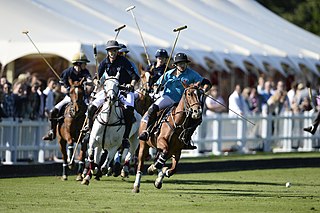
Polo or Chovgan is a ball game that is played on horseback, a traditional field sport and one of the world's oldest known team sports. It originated in ancient Persia, dating back over 2,000 years. Initially played by Persian nobility as a training exercise for cavalry units, polo eventually spread to other parts of the world. The game is played by two opposing teams with the objective of scoring using a long-handled wooden mallet to hit a small hard ball through the opposing team's goal. Each team has four mounted riders, and the game usually lasts one to two hours, divided into periods called chukkas or chukkers.

The 3rd millennium BC spanned the years 3000 to 2001 BC. This period of time corresponds to the Early to Middle Bronze Age, characterized by the early empires in the Ancient Near East. In Ancient Egypt, the Early Dynastic Period is followed by the Old Kingdom. In Mesopotamia, the Early Dynastic Period is followed by the Akkadian Empire. In what is now Northwest India and Pakistan, the Indus Valley civilization developed a state society.

The 4th millennium BC spanned the years 4000 BC to 3001 BC. Some of the major changes in human culture during this time included the beginning of the Bronze Age and the invention of writing, which played a major role in starting recorded history.
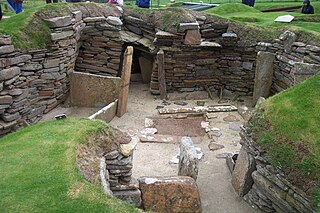
Neolithic architecture refers to structures encompassing housing and shelter from approximately 10,000 to 2,000 BC, the Neolithic period. In southwest Asia, Neolithic cultures appear soon after 10,000 BC, initially in the Levant and from there into the east and west. Early Neolithic structures and buildings can be found in southeast Anatolia, Syria, and Iraq by 8,000 BC with agriculture societies first appearing in southeast Europe by 6,500 BC, and central Europe by ca. 5,500 BC (of which the earliest cultural complexes include the Starčevo-Koros, Linearbandkeramic, and Vinča.
The 32nd century BC was a century lasting from the year 3200 BC to 3101 BC.
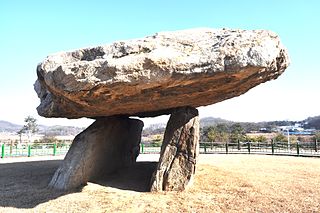
A megalith is a large stone that has been used to construct a prehistoric structure or monument, either alone or together with other stones. There are over 35,000 structures or arrangements in Europe alone, located widely from Sweden to the Mediterranean sea.

Ġgantija is a megalithic temple complex from the Neolithic era, on the Mediterranean island of Gozo in Malta. The Ġgantija temples are the earliest of the Megalithic Temples of Malta and are older than the pyramids of Egypt. Their makers erected the two Ġgantija temples during the Neolithic, which makes these temples more than 5,500 years old and the world's second oldest existing manmade religious structures after Göbekli Tepe in present-day Turkey. Together with other similar structures, these have been designated a UNESCO World Heritage Site, the Megalithic Temples of Malta.

Naqada III is the last phase of the Naqada culture of ancient Egyptian prehistory, dating from approximately 3200 to 3000 BC. It is the period during which the process of state formation, which began in Naqada II, became highly visible, with named kings heading powerful polities. Naqada III is often referred to as Dynasty 0 or the Protodynastic Period to reflect the presence of kings at the head of influential states, although, in fact, the kings involved would not have been a part of a dynasty. In this period, those kings' names were inscribed in the form of serekhs on a variety of surfaces including pottery and tombs.
The following events occurred in architecture in the 4th millennium BC:

The Megalithic Temples of Malta are several prehistoric temples, some of which are UNESCO World Heritage Sites, built during three distinct periods approximately between 3600 BC and 2500 BC on the island country of Malta. They had been claimed as the oldest free-standing structures on Earth until the discovery of Göbekli Tepe in Turkey. Archaeologists believe that these megalithic complexes are the result of local innovations in a process of cultural evolution. This led to the building of several temples of the Ġgantija phase, culminating in the large Tarxien temple complex, which remained in use until 2500 BC. After this date, the temple-building culture disappeared.

The Tarxien Temples are an archaeological complex in Tarxien, in the Port region of Malta. They date to approximately 3150 BC. The site was accepted as a UNESCO World Heritage Site in 1992 along with the other Megalithic temples on the island of Malta.
Religion has been a factor of the human experience throughout history, from pre-historic to modern times. The bulk of the human religious experience pre-dates written history, which is roughly 5,000 years old. A lack of written records results in most of the knowledge of pre-historic religion being derived from archaeological records and other indirect sources, and from suppositions. Much pre-historic religion is subject to continued debate.

Nubia is a region along the Nile river encompassing the confluence of the Blue and White Niles, and the area between the first cataract of the Nile or more strictly, Al Dabbah. It was the seat of one of the earliest civilizations of ancient Africa, the Kerma culture, which lasted from around 2500 BC until its conquest by the New Kingdom of Egypt under Pharaoh Thutmose I around 1500 BC, whose heirs ruled most of Nubia for the next 400 years. Nubia was home to several empires, most prominently the Kingdom of Kush, which conquered Egypt in the eighth century BC during the reign of Piye and ruled the country as its 25th Dynasty.
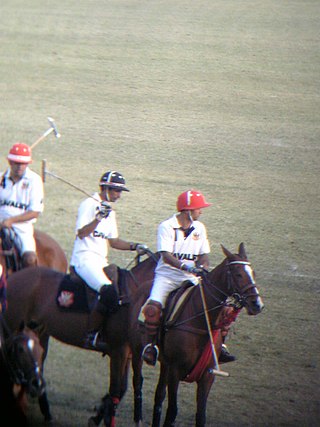
India is the birthplace of modern polo. The modern game of polo is derived from Manipur, where the game was known as sagol kangjei, kanjai-bazee, or pulu. It was the anglicised form of the last, referring to the wooden ball that was used, which was adopted by the sport in its slow spread to the west.

Manipur is home to a population playing many different sports.
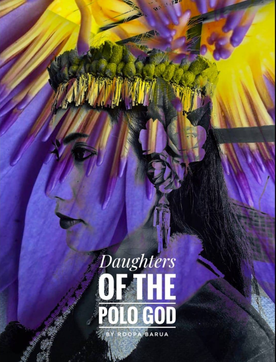
Daughters of the Polo God is a 2018 Indian Meitei-English bilingual documentary film directed by Roopa Baruah and edited by Hemanti Sarkar. It is based on the story of girls and horses empowering each other. It is about saving the endangered Meitei horse and empowering women in the sport of polo simultaneously.

Marjing is the God of horses, polo, hockey, sports and war in Sanamahism, the indigenous religion of Manipur. The guardianship of the north eastern direction is alluded to Marjing and the other directions to Koupalu, Thangching and Wangpulen. According to the legend, he invented the game of polo and introduced it as the national game. He and his divine creature, Samadon Ayangba, reside in the top of the Heingang Ching.

The Manung Kangjeibung is an old polo field located to the south west of the citadel inside the Kangla Fort in Imphal West district of Manipur. In ancient times, only royalties and nobilities were allowed to play the game of polo in this royal playground. It is one of the two most ancient pologrounds in the world, the other one being the Mapal Kangjeibung .

The Marjing Polo Statue is a colossal classical equestrian statue of a player of Sagol Kangjei, riding a Meitei horse, constructed at the Marjing Polo Complex, the sacred sports site dedicated to God Marjing, the ancient Meitei deity of polo and horses, in Heingang, Imphal East District, Kangleipak . It is the world's tallest statue of a polo player. It is built to commemorate the game of "modern polo" being originated from Kangleipak.

Sagol Kangjei is a traditional Meitei ball sport played on horseback with a long-handled stick. The sport, also known as Manipuri polo, is a predecessor of modern international polo.


















